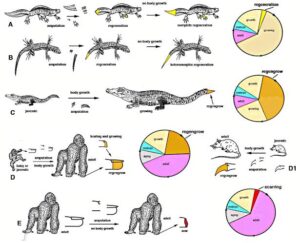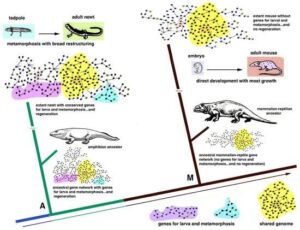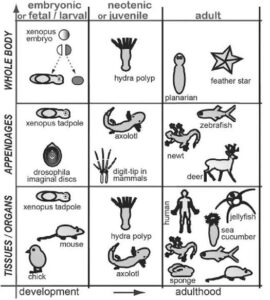Back to: ZOOLOGY 200 Level
It’s wonderful to be with you once again as we explore some amazing concepts in Zoology. Today, we’ll talk about regeneration, larval forms, and symmetry—three fascinating biological features that help organisms grow, heal, and take shape in unique ways. By the end of this lesson, you’ll have a better understanding of how these processes work and why they are so important in the animal kingdom.
Regeneration, larval forms, and symmetry
Regeneration in animals
Regeneration is the ability of an organism to regrow lost or damaged body parts. It’s a remarkable process that can vary greatly across different species. Some animals have amazing regenerative capabilities, allowing them to recover from injuries that would be fatal to other creatures.

- Examples of regeneration:
- Starfish: A starfish can regenerate its lost arms. If it loses an arm due to injury, it can grow a new one, often within a few months.
- Planarians: These flatworms have extraordinary regenerative abilities. If a planarian is cut into pieces, each piece can regenerate into a whole new individual.
- Axolotls: This aquatic salamander is well-known for its ability to regenerate not only limbs but also its heart, spinal cord, and parts of its brain.
Regeneration plays a vital role in the survival of these species, allowing them to recover from physical damage and continue to grow, reproduce, and thrive in their environments.
Larval forms and metamorphosis
Many animals go through a process of metamorphosis, a dramatic transformation from one form to another during their development. This often begins with a larval stage.
- What are larvae?
Larvae are the juvenile form of many animals, and they often look very different from the adult form. The larval stage is a crucial part of the life cycle for many species, especially insects, amphibians, and some marine animals. - Examples of larvae:
- Butterflies: Butterflies begin their lives as caterpillars (larvae). After a period of growth, they undergo metamorphosis, turning into pupae (chrysalises), before emerging as adult butterflies.
- Frogs: Frogs hatch from eggs as tadpoles (larvae) and undergo metamorphosis to transform into adult frogs with legs and lungs instead of tails and gills.
- Fish: Fish, such as salmon, hatch as larvae and gradually develop into adult fish over time, often undergoing significant physical changes.

Metamorphosis allows animals to occupy different ecological niches during their life cycle. For example, larvae might feed in a different way or habitat compared to their adult form, reducing competition for resources.
Symmetry in animals
Symmetry refers to the arrangement of body parts in an organism. It is a key characteristic in the classification of animals and plays a major role in their functionality and movement.
- Types of symmetry:
- Bilateral symmetry: Animals with bilateral symmetry have bodies that can be divided into two equal halves along a central axis. Most animals, including humans, have bilateral symmetry. This type of symmetry is important for efficient movement, especially in animals that move in one direction, like humans, dogs, and fish.
- Radial symmetry: Animals with radial symmetry have body parts arranged around a central point, like spokes on a wheel. Examples include starfish, jellyfish, and sea anemones. Radial symmetry allows these animals to interact with their environment from all directions, which is useful for stationary or slow-moving creatures.
- Asymmetry: Some animals, like sponges, lack any symmetry. They have an irregular shape, and their bodies are not symmetrical. Asymmetry is often seen in simple organisms that do not have complex body structures.

Symmetry helps animals with movement, feeding, and responding to their environment. For example, bilateral symmetry allows for directional movement, while radial symmetry supports a more passive lifestyle, like that of a jellyfish floating with the current.
Summary
In this lesson, we explored three important biological features: regeneration, larval forms, and symmetry. Regeneration allows animals to regrow lost body parts, ensuring survival. Larval forms and metamorphosis are key stages in the life cycle of many animals, helping them adapt to different environments. Symmetry, whether bilateral, radial, or asymmetrical, plays a crucial role in how animals move, feed, and interact with their surroundings.
Evaluation
- What is regeneration, and why is it important for certain animals?
- Describe the process of metamorphosis with examples of animals that undergo it.
- What is the difference between bilateral and radial symmetry?
- Give an example of an animal that exhibits asymmetry.
Keep going, my curious learner! You’ve just explored how animals regenerate, develop from larvae, and how their body structures help them survive. You’re building a fantastic foundation in Zoology, and I can’t wait to see you continue on this journey with Afrilearn. Stay motivated, and let’s keep learning!
